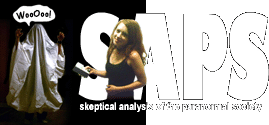Electronic Voice Phenomenon
A look at the possibilities...
Electronic Voice Phenomenon refers to the idea that spirits can communicate via tape recorder. You can't hear the spirit's voice when you're recording, but later, when you play it back, you might hear voices on the tape that weren't there.
This is a terrible source of evidence for paranormal investigators. It's yet another instance where the only thing proving the experience as paranormal is the word of the investigator themself. An audio recording has no picture. Any number of people could be standing around the tape recorder faking the evidence. And who would know?
Assuming that the recordings are not fake, it is odd that the spirits never seem to give a direct answer to the questions asked of them. Since the spirits are so off-topic, this may be taken as a sign that the recorder is actually picking up radio waves from somewhere else. This isn't very rare.
The more likely explanation is pareidolia (called "matrixing" by some investigative groups). Pareidolia refers to the brain's tendency to perceive obscure stimulus as being clear. You can try this at home with a tape recorder in a non-haunted area. The ambient sounds - sounds around you that you aren't aware of - will take on a new meaning when you play back the audio, especially if they aren't immediately identifiable. The sniffing of a dog, or the beating of a bird's wings can become a whispering voice saying your name. To test the pareidolia theory, play back a recording of an EVP for a person without telling them what they are listening to or for. Do not tell them it is a supposed EVP, and do not tell them what the voice is saying. Say only, "Will you listen to this?". There is much evidence that people have to be primed to hear what EVPs are saying, as everyone has the ability to hear what they wish.
Another perception illusion is called Apophenia. It refers to the mind's ability to make patterns where there are no patterns. Random noise, watching cars go by on the highway, studying phone numbers. All these things can make people seek patterns in the nonsense. We are beings designed to classify information. You can observe this tendency by watching static on television or getting an MRI at the doctor's office. Though the noises of both are completely random, the brain will attempt to classify it through patterns and clarity, as though the sounds are running through a mind filter.
It isn't so much the way things are recorded that brings up the possibility of debate, but the way that the human ear hears and the brain processes it. It leaves us wide open for interpretation of many simple observable phenomena.
For further reading:
- http://skepdic.com/evp.html
- http://skepdic.com/pareidol.html
- http://www.languagehat.com/archives/001804.php
- http://rabi.phys.virginia.edu/HTW/page1.php?QNum=1421
- http://lp2cd.com/audio_terms/i/interference.html
Back to the reports.
